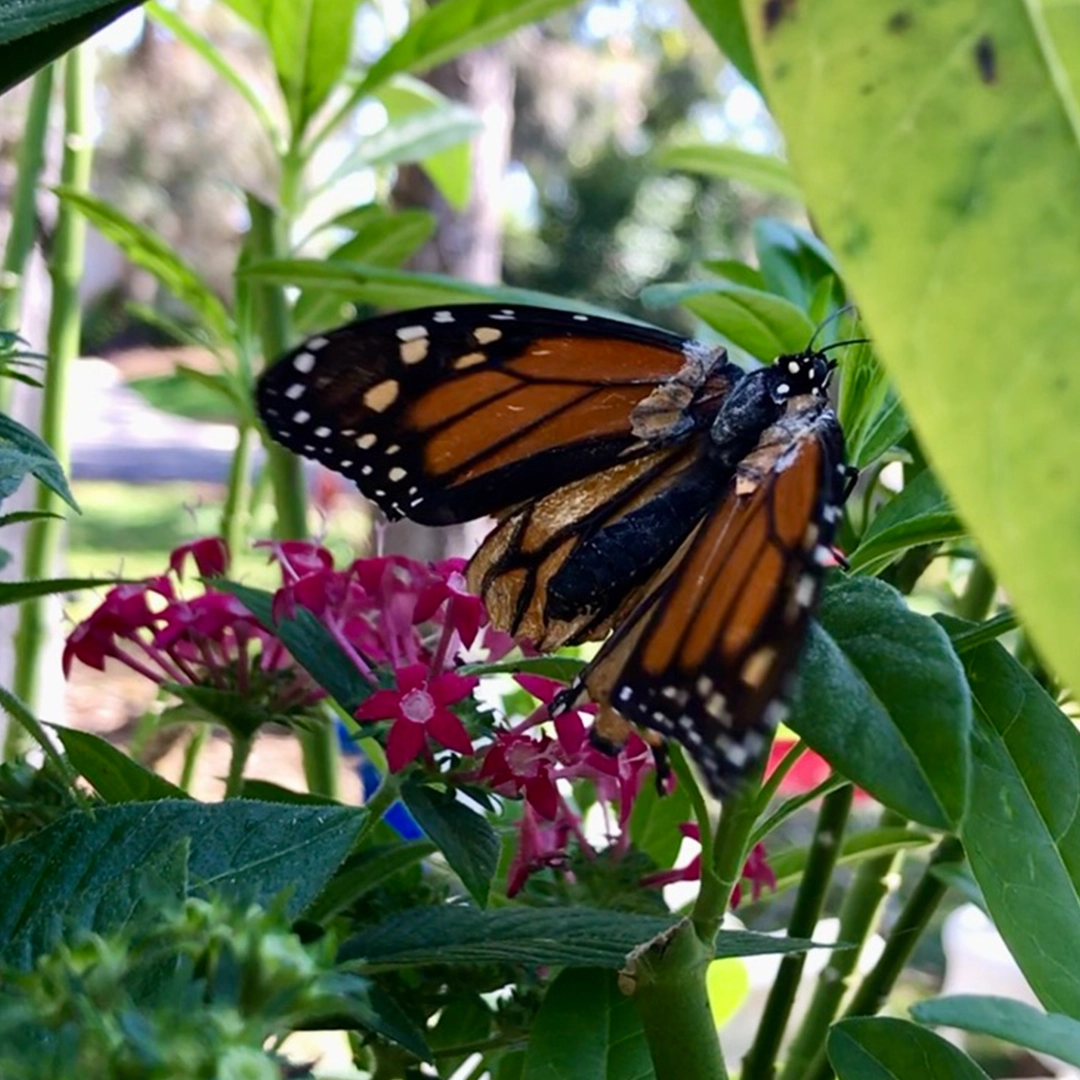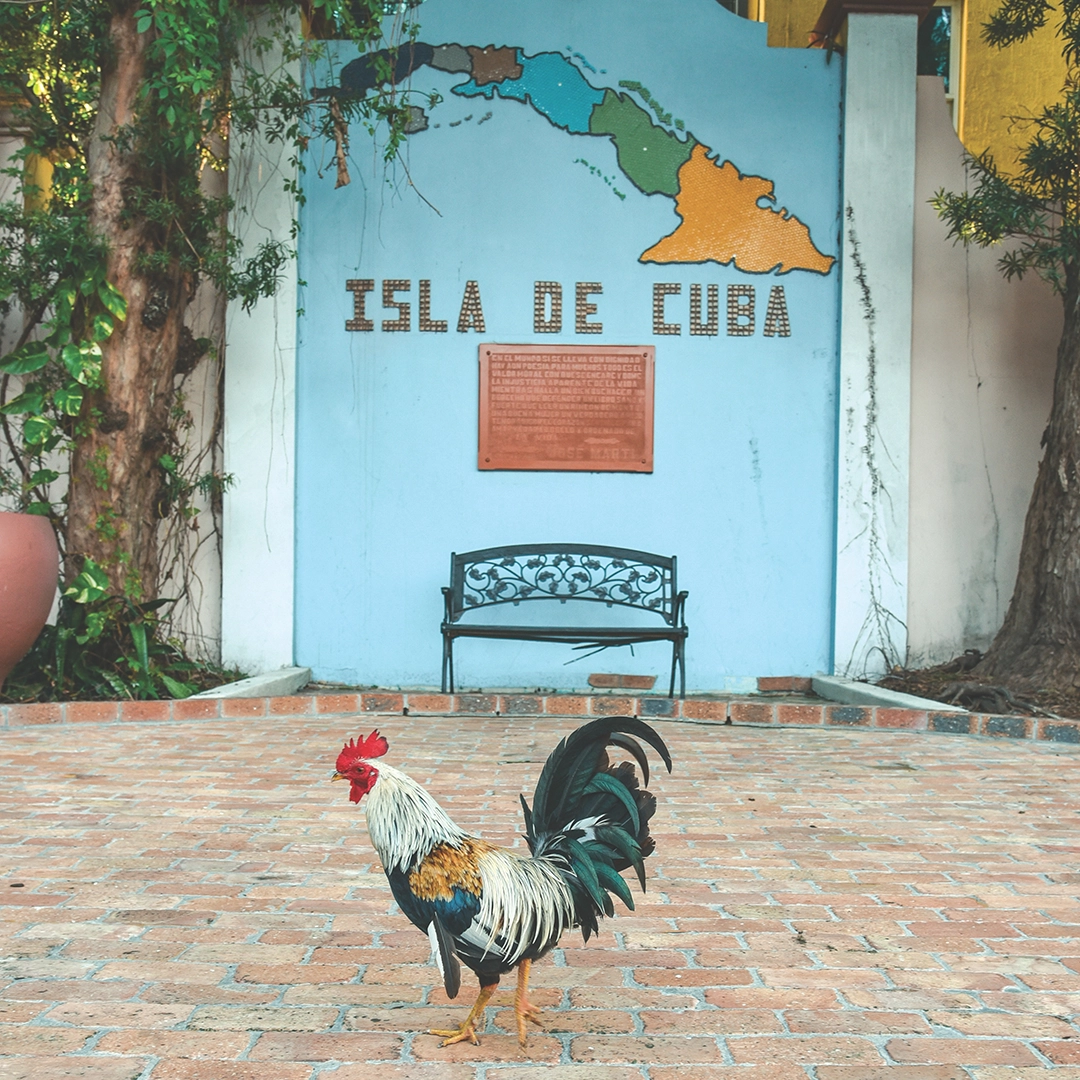by Diane Roberts | April 22, 2021
Take a Walk on the Wild Side
How one Floridian helped save the state’s wildflower crops and along with them the precious pollinators that rely on those colorful fields of flora for their survival

Photography by Mark Wallheiser.
The country between Hosford and Tate’s Hell in the Panhandle along State Road 65, the deep heart of the Apalachicola National Forest, is like something from a fever dream: a hundred shades of hot green new leaves on the palmettos, skinny pines tall as church spires, and, blooming just off the shoulder of the road, white and pink clusters of wildflowers: Osceola’s plume, graceful sun-colored spring helenium, and butter yellow colic root. We’ve pulled off the blacktop on an April morning to wade into a sawgrass bog punctuated by cypress knees and white starbursts of daisy fleabane. We marvel at the thousands of neon-bright pitcher plants thrusting up out of the water, their chartreuse trumpet-shaped blossoms open to the sky and wet with nectar, waiting for some hapless fly, an unwitting beetle, or even an overconfident frog to perch on the lip of the flower and take a long, sweet drink. The next thing the critter knows, it’s what’s for dinner, slipping down to the bottom of the bloom where it’s trapped by tiny “hairs,” and drowns.
“Every time I’m driving on rural roads, whenever I see unmowed wildflowers, I immediately think of Eleanor. It brings a smile to my face.”
—Jeff VanderMeer
There are miles of animal-eating plants along North Florida’s back roads, not just these tall, flashy green ones but rosy pink ones and low-to-the-ground ones, like the parrot pitcher plant, the color of a fine Pinot Noir. This lonely highway meandering through the vast Apalachicola National Forest showcases a wonderland of wild flora in one of the planet’s most biodiverse areas. But without a cadre of devoted activists, led by an elegant, soft-spoken 76 year-old Tallahassee lady named Eleanor Dietrich, the roadside would be mowed short as a suburban lawn, rare plants killed, important habitat for native insects, pollinators and birds destroyed. Twelve years ago, she began working with Florida naturalists to convince the engineering types at the Florida Department of Transportation to understand that the land along the roads is not empty space, but teeming with necessary life. She was a prime instigator of Florida’s designated Wildflower Areas, 12,000 miles of roadside from Pensacola to the Keys where special management allows rain lilies, leafless beaked orchids, climbing asters and lyreleaf sage to flourish for all to see and understand their value. “You cannot love what you cannot see,” Dietrich says.

Liz Sparks, who succeeded her as the Florida Wildlife Federation’s liaison to FDOT last year, says, “Eleanor has been the heart and soul of the roadside wildflower program,” noting that the model for wildflower conservation she crafted has been used statewide to create roadside wildflower corridors of pollinator habitat.
Dietrich is also an inspiration and a teacher for those of us who’d like to make our own habitats more Florida-friendly. Her thriving Tallahassee garden demonstrates that you don’t have to be a botanist to turn your yard into a haven for native plants and animals. One of her admirers, the novelist and environmentalist Jeff VanderMeer, calls her “instrumental” in educating him, sharing both her knowledge and some of her fringed campions, a critically endangered flower of the Apalachicola basin: Along with Native Nurseries, a Tallahassee garden center dedicated to “to manage lands, yards and gardens to benefit native wildlife,” VanderMeer considers Dietrich the biggest influence on his own rewilding efforts to cultivate indigenous plants and eliminate non-native species at his home. “Every time I’m driving on rural roads, whenever I see unmowed wildflowers, I immediately think of Eleanor. It brings a smile to my face,” he says.

He said native insects only eat native plants, and without the insects, you don’t have birds. That got me thinking, what could I do?
—Eleanor Dietrich
I’m thinking of her, too, as I wade through shin-deep water with Kati Schardl, a friend and student of Dietrich who started going on wilderness walks with her seven or eight years ago. Schardl points out a tiny rose pogonia–less formally known as a snakemouth orchid–as well as orange candyroot, lavender pink swamp coreopsis, and bog buttons (Lauchnocaulon anceps, if you want to be fancy), which look like a white ball on top of a thin hairy stalk. “The thing about Eleanor,” Schardl says, “[is] she takes this vast, mysterious entity—the forest—and teaches you to see it in detail, making it personal, naming these wonders.”

The thing about Florida’s wonders, unfortunately, is that we’re losing them—and fast. Every year, 170 square miles of natural land disappears under concrete and asphalt. Too many people look at our pine uplands, our hardwood hammocks or even our wetlands, and somehow think they’d be much better with, say, some condos, a strip mall, or a “golf course community” built on them, maybe a six-lane road running through for good measure. This isn’t merely ugly sprawl, it’s self-defeating. When wetlands are ruined, trees felled, and wildflower-nurturing soil is ravaged by chemicals, our state’s bugs, bees and birds have nowhere to live and nothing to eat. In case you can’t conjure up much sympathy for pollinators, remember: if they don’t eat, you don’t eat. Chocolate, oranges, broccoli, cauliflower, grapefruit, cucumbers, watermelons, coffee, tomatoes, avocados, blueberries, strawberries and a truckload of other crops depend on them. The Florida Wildflower Foundation estimates that wildflower preservation is worth over $2 billion a year to Florida agriculture.
Spared the Blade
Eleanor Dietrich grew up in Tallahassee, the eldest child of a Florida State University sociology professor father and an artist mother who stayed home to raise her family–and flowers; Sue Eleanor Brown Dietrich grew 100 varieties of chrysanthemum and passed on a love of plants to her daughter. Eleanor Dietrich graduated in 1965 from Florida Presbyterian College (now Eckerd) with a degree in Psychology, went on to the University of Florida for a Masters in Guidance and Counseling, and spent time in Malaysia with the Peace Corps. She says she wasn’t always interested in native plants but over the years found herself becoming more and more fascinated by Florida’s cornucopia of landscapes. In 2009, she was listening to an interview on NPR with Doug Tallamy, a distinguished entomologist, about his book, Bringing Nature Home. “He said native insects only eat native plants, and without the insects, you don’t have birds,” she recalls. “That got me thinking, what could I do? I had a… what’s the word when you become a Christian? A conversion.”

She began this conversion in her own backyard and by exploring in the Apalachicola National Forest, hunting for rare plants–not, I hasten to add, to dig up, but to observe, educating herself on ecosystems. She wanted to change the way the state regards its natural areas as well as prove that a single person could take a small area and transform it into a habitat friendly to native flora and fauna. Meanwhile, more and more Floridians were becoming alarmed at the way wild things seemed to be considered expendable by officialdom. Citizens in Wakulla and Franklin counties became outraged when their favorite sprawl of wildflowers in full bloom got hacked down by FDOT landscaping crews, especially during Monarch butterfly migration. One day Dietrich got a call from her friend Grant Peeples, a local musician and activist, incensed over the department cutting a lush stand of wildflowers beside Highway 98. He’d been mullet fishing near Carrabelle, and, as he was about to head home, saw a field of sunny yellow coreopsis on the side of the road: “There were so many,” he says, “and so many pollinators, bees and butterflies.”

Peeples threatened to lie down in front of the state mowers next time. Instead, he became one of the many Floridians supporting Dietrich and the Florida Wildflower Foundation as they worked to convince FDOT to understand that what the road guys saw as disorderly growth, even unsightly weeds, alongside state roads were not a problem to be eradicated but an opportunity to be embraced. Actually, the state already had a sort of wildflower program, dating back to1963, but it was not based on good ecological science. Many of the “wildflowers” along the roads and in the medians, were not wild or native. Crimson clover, for example, had been planted by a cattle rancher as winter forage. The rancher later sold sod to a road builder, and soon clover sprang up along U.S. 27 south of Tallahassee. Nor was the program grounded in good maintenance practices. Gary Peters, an FDOT landscape architect who worked in the wildflower program, did not consider it a success. As he remarked later, “We were using non-native seed and planting out of season.”
By 2010, several North Florida counties had passed Wildflower Resolutions, urging FDOT to change its ways. The idea was to keep pollinator corridors intact, mowing everything only in the months of December and January, after the plants had spread their seeds, and mowing only 10 to 15 feet from the pavement, allowing native plants to flourish in their original place. It probably didn’t hurt that not mowing so much saves the state a lot of money. A 2014 study by the FDOT estimates a saving of about $11 million a year.

Designating wildflower roads was “not an unreasonable request and not crazy,” Dietrich says. That doesn’t mean it’s always easy. First, advocates had to get their city or county commission to approve a Wildflower Resolution, then they had to send DOT an official letter listing which areas of which roads should be spared the blade. There’s a lot of local lobbying involved. Peeples and Schardl describe Dietrich’s powers of persuasion as formidable. She’d show up at the grocery store in Sumatra or some little cafe in Liberty County where the local politicos would have lunch, and “charm those old white men who didn’t know they’d ever do anything to protect wildflowers,” Peeples says. Dietrich practices what she calls “the three P’s” to accomplish her goal: “Be patient, be persistent, and be pleasant.”
A Green Thought in a Green Shade
I grew up thinking that a proper yard (in my part of Florida, at least) consisted of a velvety grass lawn, Formosa azaleas, camellias and crepe myrtles, with a few “ornamental” bushes like nandina, and flower beds full of roses, snapdragons, pansies, and petunias–a kind of Deep South-meets-English-cottage style. But none of those plants are indigenous to Florida. They don’t provide any nourishment to insects or birds, and some, like Nandina domestica, are not only invasive, their berries are poisonous to birds such as robins and mockingbirds, and as they break out of the suburbs into natural areas, choke out rare beauties like the fringed campion. Once I heard that, I was even more determined to get rid of that damned nandina (as well as demonic exotics such as Coral ardisia), but seeing Dietrich’s rewilded backyard native garden has inspired me to get on the stick, horticulture-wise.

And what a backyard it is. While you might reasonably assume that the tutelary spirit of Florida flora would live in a remote, undeveloped corner of the state, her house is actually bang in the middle of Tallahassee, in an old tree-shaded neighborhood not far from a cacophonous main road with fast-food joints and shopping centers. Blue-eyed grass, red and yellow columbine, woodland phlox with pale violet and pink flowers, white petaled bloodroot, and the lushest maidenhair fern I’ve ever seen all flourish amid oaks, black gums and sweetbay magnolias. Standing next to a red buckeye tree, I can’t see the buildings I know are only a couple of hundred yards away or hear anything but a pileated woodpecker drumming on dry wood. If there was ever a place to afford you a “green thought in a green shade,” it’s here.

Dietrich, along with her friend Hector Navas, owner of a tree service, began clearing the undergrowth on her property in 2009. These days Hector’s wife Leticia Tenes, like him originally from Guatemala, also helps out with mulching and new planting. They’ve created what Dietrich calls “islands” of ground with wild native azaleas (not the imports) that bloom shell pink and flame-colored in spring, along with fringe trees dripping with gossamer white blossoms, walking irises, mysterious trilliums, and yellow jessamine, connected by curving paths that glitter in the dappled sunshine. Hector made them himself and inlaid the concrete with colored glass and bright pebbles. “We didn’t really choreograph or orchestrate the garden,” she says, “it just sort of grew.”
It’s still growing; it’s still inspiring. “One thing I love about Tallahassee,” says Jeff VanderMeer, “is that despite the loss of some of our canopy, there are still so many hidden forests quite close to downtown. But I have to say that the most magical of all is Eleanor’s. When I first saw it, my jaw dropped—all those old oak trees, the sense of calm. It was a moment I will remember for the rest of my life.”
Eleanor Dietrich may have retired from the Florida Wildflower Association, but she hasn’t retired from her mission to foster the native glories of her state and educate us all, one convert at a time. “She didn’t just show me the plants,” says Schardl, “she told their stories. She helped make them mine. Now the connection is eternal.”
Eleanor Dietrich smiles quietly. “I’m just happy every day to live here.”





